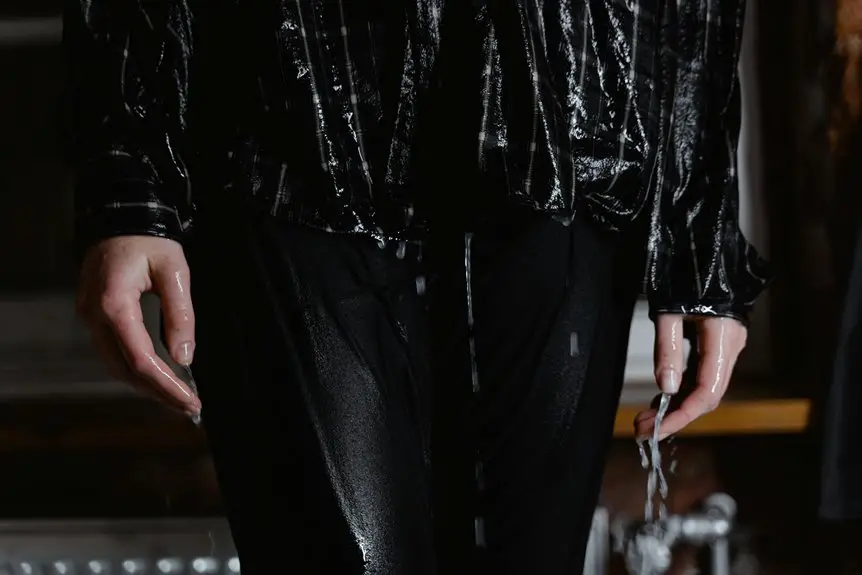You might not realize how much your clothing influences body odor, especially when you’re active. Moisture-wicking fabrics are designed to pull sweat away from your skin, but does that really make a difference in how you smell? Understanding how these materials interact with sweat and bacteria could change the way you choose your workout gear. There’s more to this than just staying dry—let’s explore the science behind it.
Table of Contents
Key Takeaways
- Moisture-wicking fabrics pull sweat away from skin, keeping it dry and reducing bacteria-friendly environments that cause body odor.
- By promoting faster evaporation, these fabrics prevent sweat pooling that leads to increased bacterial growth and odor.
- Unlike cotton, moisture-wicking synthetics reduce trapped sweat, which helps minimize odor development.
- Some moisture-wicking clothes include antimicrobial treatments that inhibit bacteria responsible for body odor.
- Innovations in sustainable, odor-resistant fabrics combine effective moisture management with eco-friendly benefits.
How Moisture-Wicking Fabrics Work to Manage Sweat
Although you mightn’t notice it right away, moisture-wicking fabrics actively pull sweat away from your skin to help you stay dry. When you wear these clothes, their fibers quickly draw moisture to the surface, where sweat evaporation happens faster. This process prevents sweat from pooling on your skin, reducing discomfort and irritation.
The fabric breathability plays an essential role here—it allows air to circulate freely, speeding up evaporation and keeping your body cooler. Unlike traditional cotton, which soaks up sweat and stays damp, moisture-wicking materials keep you feeling fresh by managing moisture efficiently.
The Connection Between Sweat, Bacteria, and Body Odor
When sweat stays on your skin, it creates a perfect environment for bacteria to thrive. Sweat itself is mostly water, but its composition includes proteins and lipids that bacteria feed on. As bacterial growth increases, these microbes break down sweat components, producing the unpleasant odors you associate with body odor.
| Sweat Component | Source | Effect on Bacteria |
|---|---|---|
| Water | Eccrine glands | Moisture enables growth |
| Proteins | Apocrine glands | Nutrient source |
| Lipids | Apocrine glands | Fuel for bacterial growth |
| Salts | Eccrine glands | Alters bacterial activity |
| Metabolites | Skin surface | Byproducts cause odor |
Understanding this connection helps you see why managing sweat composition and bacterial growth is key to controlling body odor.
Impact of Different Fabric Types on Odor Control
Since the type of fabric you wear directly affects how sweat interacts with your skin, choosing the right material plays an essential role in controlling body odor.
When comparing cotton vs. polyester, natural fibers like cotton tend to absorb sweat, which can trap moisture and bacteria, potentially worsening odor.
Polyester, a synthetic fiber, wicks moisture away from your skin, keeping you drier. However, it can sometimes retain odors within the fabric itself if not properly treated.
Natural fibers breathe better but may hold onto sweat longer, while synthetic fabrics promote faster drying but vary in odor resistance.
Understanding these differences helps you pick clothes that manage moisture effectively and reduce odor, ensuring you stay fresher throughout the day.
Innovations Enhancing Moisture-Wicking and Odor Resistance
As technology advances, manufacturers are creating fabrics that not only wick moisture more efficiently but also actively combat odor.
You’ll find innovative moisture-wicking clothes made from sustainable materials like recycled polyester and organic cotton blends, reducing environmental impact while enhancing performance.
These fabrics often incorporate antimicrobial treatments that inhibit bacteria growth—the main cause of body odor—keeping you fresher for longer.
Some brands even use silver-based or plant-derived antimicrobials, which offer effective odor resistance without harmful chemicals.
By choosing garments with these innovations, you benefit from enhanced comfort and odor control during your workouts or daily activities.
This blend of sustainability and science means your clothes work harder to keep you dry and odor-free, aligning your active lifestyle with eco-friendly choices.
Challenges and Future Trends in Odor Management Textiles
Although moisture-wicking fabrics have come a long way, managing odor remains a tough challenge for textile makers. You’ll find that odor neutralizing technologies often struggle to balance effectiveness with durability and environmental impact. Sustainable fabric solutions are becoming essential as consumers demand eco-friendly options without sacrificing performance. Looking ahead, blending these innovations will define future trends.
| Challenge | Future Trend |
|---|---|
| Limited long-term odor control | Advanced encapsulated neutralizers |
| Environmental impact of treatments | Bio-based sustainable fibers |
| Cost of integrating new tech | Scalable, affordable production |
| Fabric breathability vs. treatment | Smart textiles with adaptive properties |
| Consumer preference variability | Customizable odor management systems |
You’ll see the next wave of textiles actively responding to your body’s needs while respecting the planet.
Frequently Asked Questions
Can Moisture-Wicking Clothes Prevent Odor During Intense Workouts?
You might think sweat alone causes odor, but moisture-wicking clothes manage sweat effectively, boosting workout comfort. They keep you dry, which reduces bacteria growth and helps prevent odor during your intense workouts—coincidence? Not at all!
How Should Moisture-Wicking Clothes Be Washed to Maintain Odor Control?
You should wash moisture-wicking clothes frequently using a gentle detergent choice designed for synthetic fabrics. Avoid fabric softeners, as they reduce effectiveness. This routine keeps odor control intact and preserves the fabric’s moisture-wicking properties.
Are Moisture-Wicking Fabrics Safe for Sensitive Skin?
Imagine Sarah, who suffers from sensitive skin; she found moisture-wicking fabrics with high breathability reduced skin irritation. You’ll want to choose soft, natural blends that keep your skin dry and comfortable without causing discomfort or rashes.
Do Moisture-Wicking Clothes Lose Effectiveness Over Time?
You’ll notice moisture-wicking clothes can lose effectiveness over time as fabric lifespan shortens. With repeated washing, fibers weaken, and odor retention increases, so you’ll want to replace them periodically to stay fresh and comfortable.
Can Moisture-Wicking Fabrics Be Eco-Friendly and Sustainable?
You can find moisture-wicking fabrics made from sustainable materials, like organic cotton or recycled polyester. When manufacturers use eco friendly production methods, you get performance and help reduce environmental impact simultaneously.
- Are Non-Mulesed Wool and ZQ Merino Truly Ethical Options? - June 7, 2025
- Water Usage in Wool Processing: Scouring and Dyeing - June 7, 2025
- The Land Degradation Impact of Overgrazing for Wool Production - June 7, 2025







